UAV carrier of kamikaze drones "Bee"
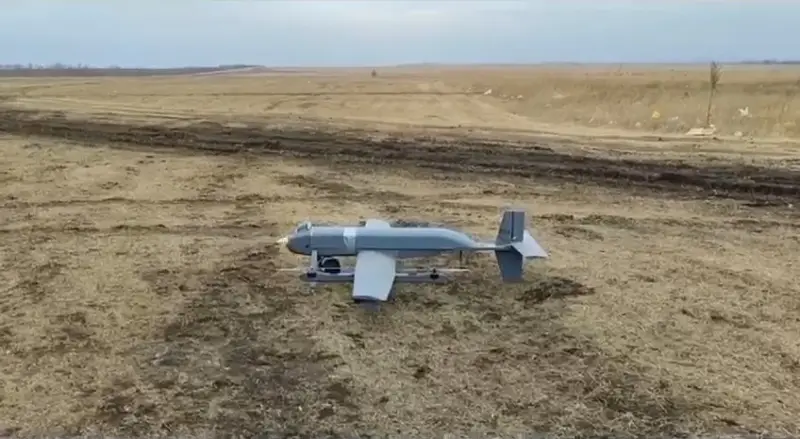
"Bee" presumably in a war zone
The list of unmanned aerial vehicles used by our army during the current Special Operation is constantly growing. Recently it became known that the troops received a multi-purpose UAV called “Bee”. It is used as a carrier for special equipment, as well as as a “womb” for light drums drones. Such a carrier significantly increases the combat radius drones-kamikaze.
Unclassified sample
On the tenth of March, Ukrainian resources reported that an unknown Russian UAV was spotted in the area of Artemovsk (Ukrainian Bakhmut). The characteristic architecture of this product was noted, but other details, for obvious reasons, remained unknown to the enemy.
On March 21, the “Russian Engineer” telegram channel revealed the first details - this became possible since the Ukrainian side had already learned about our new drone. It is reported that we are talking about a mixed-design UAV called “Bee”. Such equipment is already present in the troops and is used at the front, although the exact timing of its arrival has not been specified.
The Bee UAV has a special design that combines the components of an airplane and a helicopter, thereby achieving the desired flight and takeoff and landing characteristics. Flight is provided by an internal combustion engine and electric motors. The drone is used as a carrier for kamikaze devices and a radio signal repeater for them.
“Russian Engineer” also published a short video demonstrating the vertical take-off of a drone. In this case, the transition to horizontal flight and the completion of tasks are not shown. Also, the functions of carrying a payload in the form of small UAVs and ensuring their use have not yet been demonstrated.
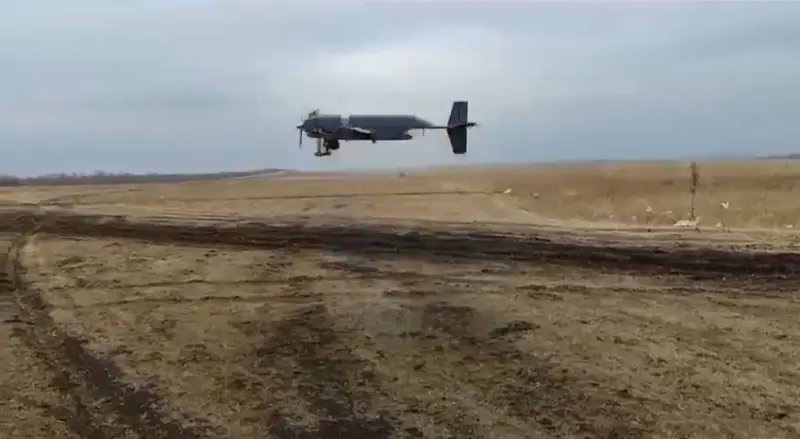
Vertical take-off "UAV"
It should be recalled that kamikaze drones have become one of the most common types of weapons in the Special Operation zone. Such products are constantly and widely used for various purposes and demonstrate high efficiency. Now we can assume that some of the enemy’s armored vehicles and positions were hit by attack UAVs using the new Bee product.
The existence of the “Bee” became known to the enemy, which makes it possible to change the secrecy mode. It should be expected that in the near future new and more complete materials will appear on the combat use of such equipment, both independently and together with lighter disposable drones.
Multi-purpose system
Judging by the appearance and stated capabilities, we are talking about the multi-purpose Pchelka UAV from Airburg JSC (Ekaterinburg). This product was first presented in July last year - then they published a brief description of the drone, revealed some of the characteristics and showed a video from flight tests. Vertical take-off, horizontal flight and subsequent landing “like a helicopter” were demonstrated.
In August, “Bee” was shown for the first time at one of the specialized domestic exhibitions. Subsequently, Airburg demonstrated its products at other events.
In December, interesting tests were carried out to solve transport problems in conditions as close as possible to real operation. The events were attended by the Ministry of Health and the Territorial Center for Disaster Medicine of the Sverdlovsk Region. The UAV received a medical cargo in the form of several ampoules with a drug and completed a flight of approx. 30 km and delivered his load to conditional patients. The tests were considered successful.
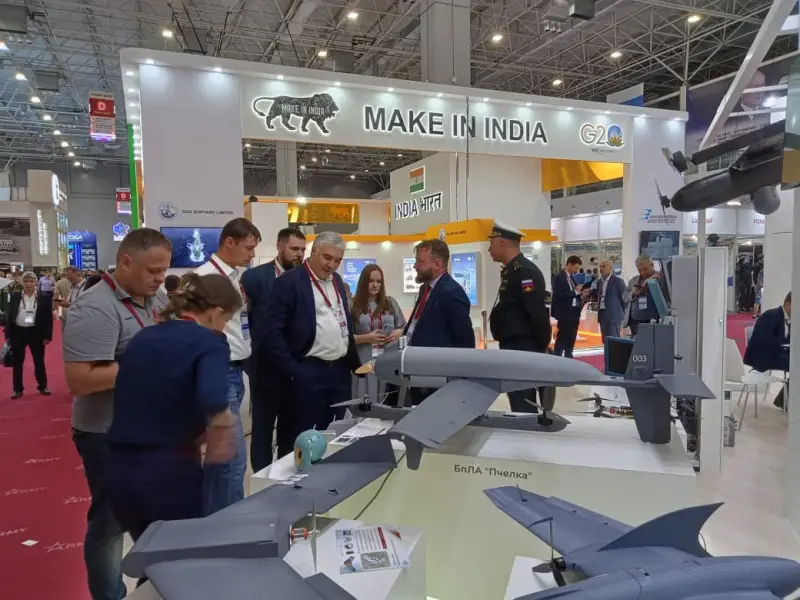
"Bee" at one of the exhibitions in 2023
Soon, in January, new tests took place, this time on the basis of the State Budgetary Institution SO "Ural Base" aviation forest protection". In this case, the Bee flew over a forest area and, using an optical-electronic station with a thermal imaging channel, identified fires in peat bogs. The reconnaissance of the area was carried out successfully and showed all the advantages of unmanned aerial platforms.
As it now turns out, a number of “Bees” have joined the troops and are mastering military specialties. They can be used as another means of optical reconnaissance, as well as as a “mother” for smaller drones. If the UAV from Airburg copes with this task and proves itself well, then we should expect its mass implementation in different units and divisions.
Technical features
"Bee" is a tiltrotor with the ability to fly vertically and horizontally. Due to the special combination of flight and takeoff and landing modes, a specific scheme and layout is used. Thus, the device has an elongated “aircraft” fuselage of variable cross-section with a thin tail boom on which the stabilizer is located, as well as a fin with a lower ridge of the same size. The UAV received a low-lying straight wing. Under the central part of the consoles there are longitudinal beams, at the ends of which there are propeller groups. In the bow there is an L-shaped landing gear. The functions of a crutch are performed by the plumage.
The dimensions and weight of the “Bee” are unknown. The length of the device can reach 1,2-1,5 m with a comparable wingspan. The payload is stated at 3 kg, and the maximum take-off weight should be several times higher.
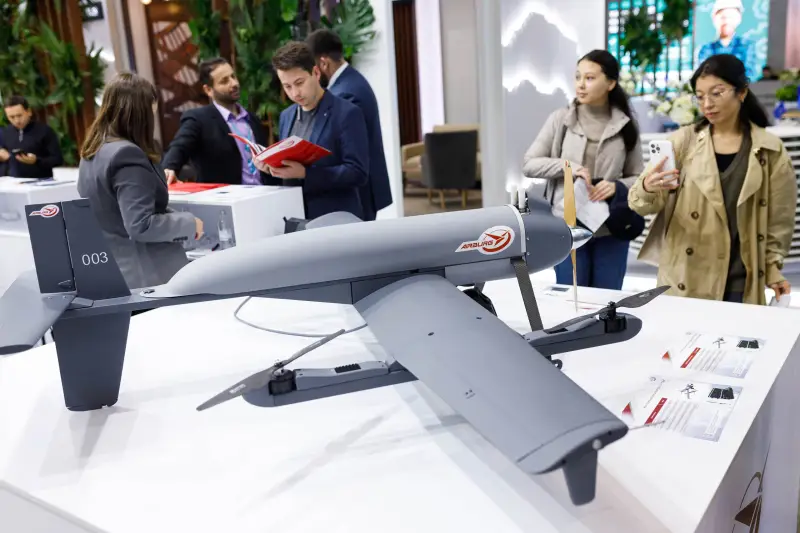
General view of the product. Characteristic architecture visible
In the forward part of the fuselage there is a compact internal combustion engine with a pulling propeller, responsible for horizontal flight. The lifting system of four propeller groups is equipped with electric motors. How exactly the operation of the two propulsion systems is organized is unknown. It is possible that the internal combustion engine and electric motors are not connected in any way and use their own power systems - from the tank and from the battery, respectively.
“Bee” is capable of taking off and landing vertically with the transition to airplane-like flight. The speed characteristics of the drone are not reported. Flight range – up to 300 km. Application altitudes – from 50 to 2500 m.
The UAV has a remote control system and two-way communication with the operator's ground station. For reconnaissance or monitoring, the Bee carries a compact spherical OES under the forward fuselage. The optics may have a day and/or night channel.
It is now known that the Bee UAV can also carry smaller drones. A method for placing such a load has not yet been demonstrated; the number of devices on an external sling is unknown. It is reported that, together with kamikaze drones, a large UAV can carry a radio signal repeater. In this case, the combat radius of attack drones increases significantly.
Promising ideas
Unfortunately, very little is known so far about the military version of the multi-purpose Pchelka UAV and its use. In fact, only the possibility of carrying small drones and the signal relay function are reported. In this regard, the new domestic unmanned aircraft system will not be able to be fully assessed.
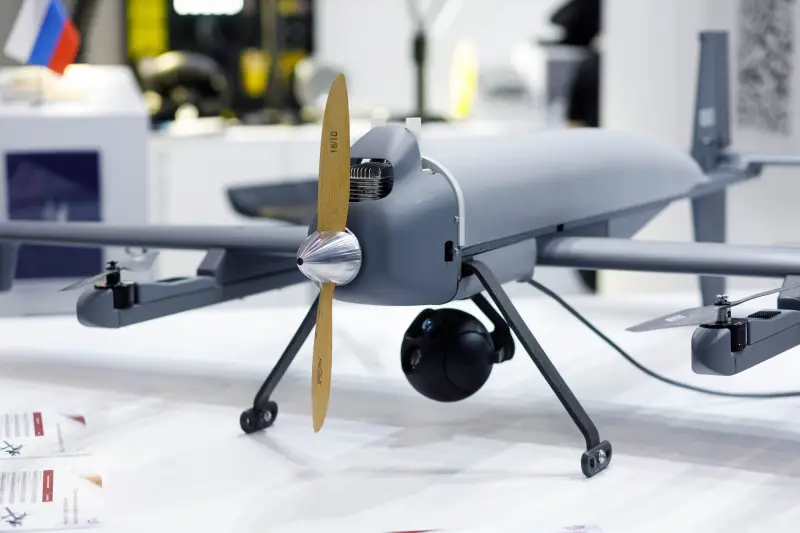
View of the bow with internal combustion engine and EPS
However, we can consider the concept on the basis of which the combat version of the Bee complex is built. The idea of placing one aircraft on another, larger one is generally obvious, but its implementation is a separate and difficult task. This concept has clear advantages associated with an increase in range and combat radius, thereby improving combat qualities in general. The repeater carrier allows you to extend the launch range of a kamikaze drone far beyond the latter’s own range and reach a more distant target.
With all this, an unmanned “uterus” of the “Bee” type can be used as a means of observation, reconnaissance and adjustment. Thanks to this, an unmanned system with two main components has the ability to independently carry out all stages of an air strike.
If a large UAV can carry several small vehicles, then the system has the ability to carry out several strikes on one target with adjustments between them, or perform a series of attacks on different objects. In both cases, the system’s own means carry out and repeat the cycle “reconnaissance – detection – launch of a kamikaze drone – recording the results.”
In general, the idea of a UAV with the ability to deploy small kamikaze vehicles looks interesting and promising. Its implementation based on the multi-purpose drone “Pchelka” also does not yet give any noticeable reasons for criticism. With all this, such a system is already used at the front and solves real combat missions. What successes it shows in a real situation will become clear later - when it will be possible not only to reveal the fact of its existence, but also to talk about its application.
Information